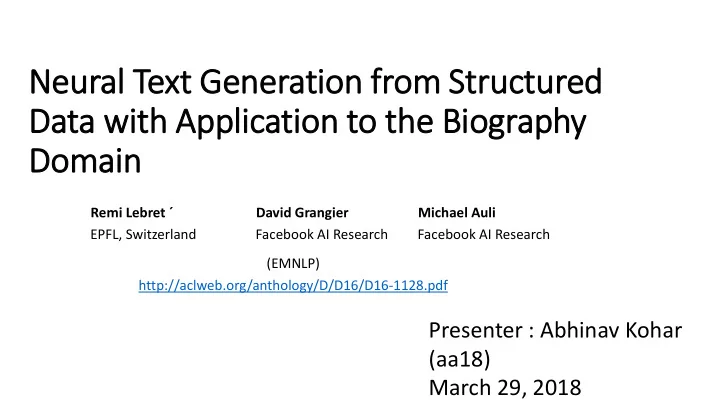

Neural Text xt Generation fr from Structured Data wit ith Appli licatio ion to the Bio iography Domain in Remi Lebret ´ David Grangier Michael Auli EPFL, Switzerland Facebook AI Research Facebook AI Research (EMNLP) http://aclweb.org/anthology/D/D16/D16-1128.pdf Presenter : Abhinav Kohar (aa18) March 29, 2018
Outline • Task • Approach / Model • Evaluation • Conclusion
Task: : Bio iography Generation (C (Concept-to to-te text Ge Gener erati tion on) • Input (Fact table/Infobox) Output (Biography)
Task: Biography Generation (C (Concept-to to-text xt Generation) • Input (Fact table / Infobox) Output (Biography) • Characteristics of the work : • Using word and field embeddings along with NLM • Scale to large # of words and fields (350 words -> 400k words) • Flexibility (does not restrict relations between field and generated text)
Table conditioned language model • Local and global conditioning • Copy actions
Table conditioned language model
Table conditioned language model
Motivation Z ct -Allows model to encode field specific regularity eg: Number of date field is followed by month , Last token of name field followed by “(” or “was born”
Why G f , G w : fields impacts structure of generation eg: politician/athlete Actual token helps distinguish eg: hockey player/basketball player
Local conditioning : context dependent Global conditioning : context independent
Co Copy Act ctions Model can copy infobox’s actual words to the output W: Vocabulary words , Q: All tokens in table Eg : If “Doe” is not in W, Doe will be included in Q as “name_2”
Mo Model • Table conditioned language model • Local conditioning • Global conditioning • Copy actions
Tr Training • The neural language model is trained to minimize the negative log-likelihood of a training sentence s with stochastic gradient descent (SGD; LeCun et al. 2012) :
Ev Evaluation • Dataset and baseline • Result • Quantitative Analysis
Dataset and Baseline • Biography Dataset : WIKIBIO • 728,321 articles from English Wikipedia • Extract first “biography” sentence from each article + article infobox • Baseline • Interpolated Kneser-Ney (KN) model • Replace word occurring in both table/sent with special tokens • Decoder emits words from regular vocab or special tokens (replace special tokens with corresponding words from table)
Template KN model • The introduction section of the table in input (shown earlier): • “ name 1 name 2 ( birthdate 1 birthdate 2 birthdate 3 – deathdate 1 deathdate 2 deathdate 3 ) was an english linguist , fields 3 pathologist , fields 10 scientist , mathematician , mystic and mycologist .”
Experimental results: Metrics
Experimental results: Attention mechanism
Quantitative analysis • Local only cannot predict right occupation • Global (field) helps to understand he was a scientist • Global (field,word) can infer the correct occupation • Date issue?
• Conclusion: • Generate fluent descriptions of arbitrary people based on structured data • Local and Global conditioning improves model by large margin • Model outperforms KN language model by 15 BLEU • Order of magnitude more data and bigger vocab • Thoughts: • Generation of longer biographies • Improving encoding of field values/embeddings • Better loss function • Better strategy for evaluation of factual accuracy
References: • http://aclweb.org/anthology/D/D16/D16-1128.pdf • http://ofir.io/Neural-Language-Modeling-From-Scratch/ • http://www.wildml.com/2016/01/attention-and-memory-in-deep- learning-and-nlp/ • https://github.com/odashi/mteval • http://cs.brown.edu/courses/cs146/assets/files/langmod.pdf • https://cs.stanford.edu/~angeli/papers/2010-emnlp-generation.pdf
Questions?
Performance : : Sentence decoding
Recommend
More recommend